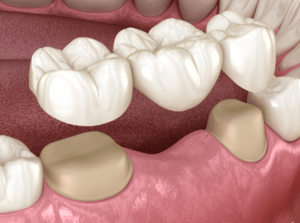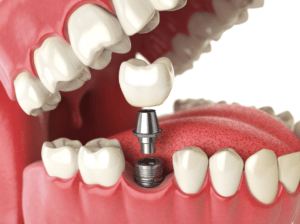Dental Bridges vs. Dental Implants


Missing teeth are a cause for concern, but fortunately, dental bridges and implants are two viable options to fill the gap in your smile. What’s the difference between the two, and which one is right for you? Learn more about dental bridges vs. dental implants to help you decide.
What is a Dental Bridge?
 Dental bridges are aptly named—they literally “bridge the gap” in your smile if you’re missing one or more teeth. A bridge is comprised of multiple parts: first, crowns cap the teeth on either side of the gap, known as the abutment teeth. Then, one or more false teeth, called pontics, are suspended between the crowns to replace the missing tooth or teeth. The false tooth may be made of porcelain, alloys, gold, or other materials.
Dental bridges are aptly named—they literally “bridge the gap” in your smile if you’re missing one or more teeth. A bridge is comprised of multiple parts: first, crowns cap the teeth on either side of the gap, known as the abutment teeth. Then, one or more false teeth, called pontics, are suspended between the crowns to replace the missing tooth or teeth. The false tooth may be made of porcelain, alloys, gold, or other materials.
If you opt for a dental bridge, your first visit with the dentist will involve preparing the abutment teeth by removing some of the enamel. This creates room to place crowns that serve as the anchors for the pontic(s) cemented between them. Next, your dentist takes an impression of your teeth to use as a model when creating custom pontics and crowns for your dental bridge. A temporary bridge protects your exposed teeth and gums until the permanent product is finished.
On your second visit, the dentist removes the temporary bridge and puts the new pontics and crowns in place. Temporary cement ensures a comfortable fit. After a few weeks, you return to the dentist one final time to have the bridge firmly cemented in place.
What is a Dental Implant?
 In the past, dental bridges were the only option for replacing missing teeth. Today, a more advanced option known as a dental implant is also available.
In the past, dental bridges were the only option for replacing missing teeth. Today, a more advanced option known as a dental implant is also available.
With this restorative dentistry option, a titanium screw is surgically positioned into your jawbone beneath the gum line. This serves as the “root” for the new artificial tooth. A second appointment takes place after the screw has bonded to your jaw bone through a process called osseointegration. At that time, a connector is secured on top of the screw, and a natural-looking crown, usually made of ceramic, is cemented on top.
Pros and Cons of Dental Bridges vs. Dental Implants
With these two viable restorative dentistry options to choose from, you might be unsure of which option is best for you. Consider the pros and cons of dental bridges vs. dental implants to help you make the correct choice.
Time
If you’re in a hurry to fix your smile, a dental bridge is the faster option. You can finish the procedure in two visits spaces within a few weeks of each other. In contrast, dental implants require a wait time of three to six months between implanting the titanium screw and topping it with a connector and crown. This gives the jaw bone time to grow around the screw before the procedure is completed.
Cost
In the debate between dental bridges vs. dental implants, cost is a significant consideration. In general, implants are more expensive than bridges, though your insurance coverage determines what you pay out of pocket. However, since implants last longer, they may actually be the more cost-effective option.
Durability
Dental implants usually last a lifetime. Dental bridges, on the other hand, typically last five to 15 years. A portion of your natural tooth remains under each crown, making a bridge more likely to fail over time. As long as you maintain meticulous oral hygiene and keep up with regular visits to the dentist, this restorative dentistry procedure should last at least a decade.
Aesthetics
Dental implants are indistinguishable from natural teeth, while bridges are slightly more noticeable because they aren’t embedded in the gum line. For this reason, bridges may be more suitable toward the back of the mouth, while implants create a completely natural-looking smile when replacing front teeth.
Oral Care
When considering dental bridges vs. dental implants, consider that both options rely on your ability to take good care of your teeth and gums. Brush twice a day, floss once a day, and use antiseptic mouthwash recommended by your dentist to keep tooth decay and gum disease at bay. Then, be aware that while flossing with an implant feels completely natural, you may need additional instructions for threading floss under the false tooth if you have a bridge.
Tooth & Jaw Health
Unlike a bridge, an implant allows your dentist to only treat the missing tooth. There is no need to grind down healthy abutment teeth to make room for anchoring crowns.
The American Academy of Implant Dentistry also points out that implants protect the integrity of the jaw bone and prevent it from shrinking, which can occur when teeth fall out or are extracted. If you fill the gap with a dental bridge, the pontic doesn’t contact the jaw bone, so there could be bone loss.
Eligibility
To qualify for a dental implant, you must have healthy gums and adequate bone structure to support the titanium screw. The teeth surrounding the gap should also be healthy. If they are, having an implant instead of a bridge preserves the integrity of these teeth.
However, if you have cavities and require fillings and crowns in the abutment teeth, a bridge may be a more suitable option. After all, your dentist can restore your damaged teeth and install a bridge at the same time.
Call for a Consultation for Dental Implants or Bridges
In the debate between dental bridges vs. dental implants, either one could be the right option depending on your specific circumstances. A consultation with Dr. Ania will reveal if you could benefit from a dental bridge or implant, and which one is better for you. Call our Boulder, CO office today at 303-443-0998 to schedule a comprehensive examination and consultation!


